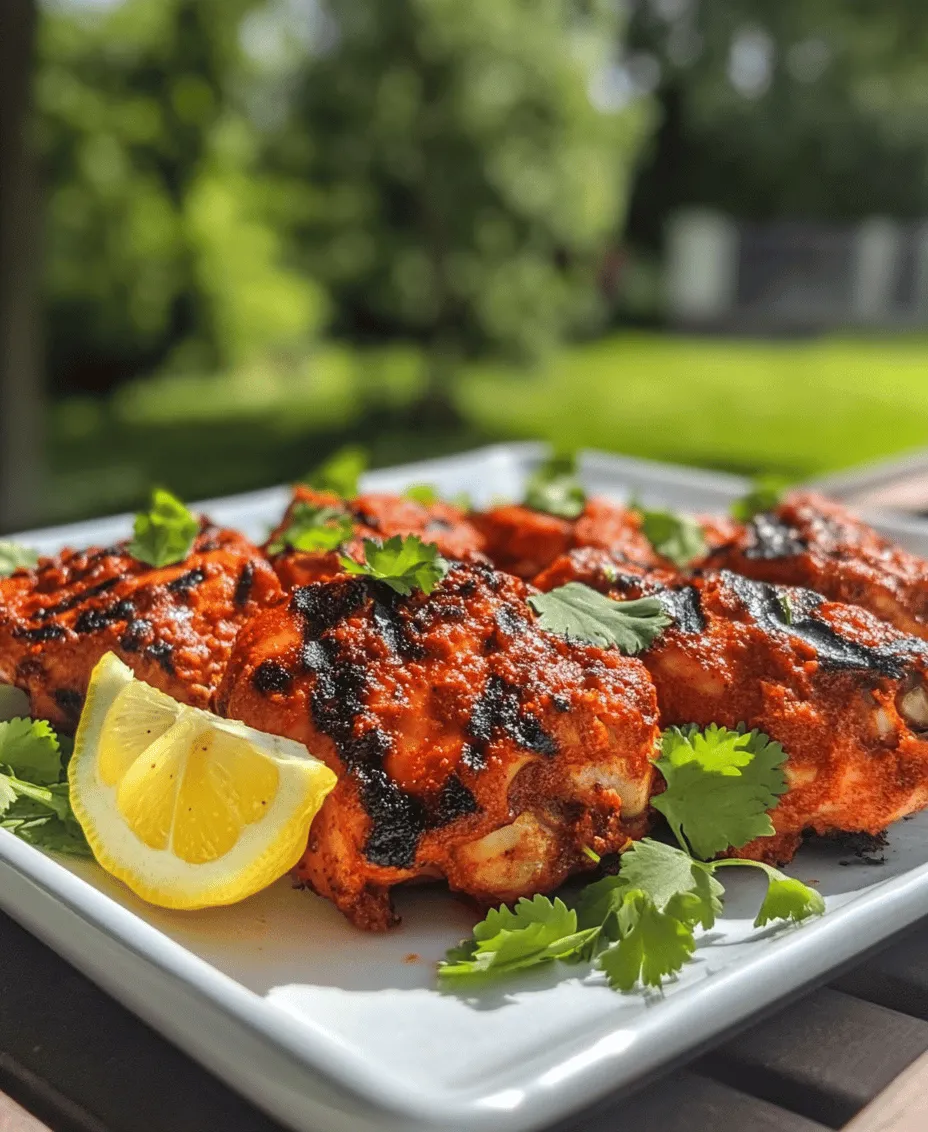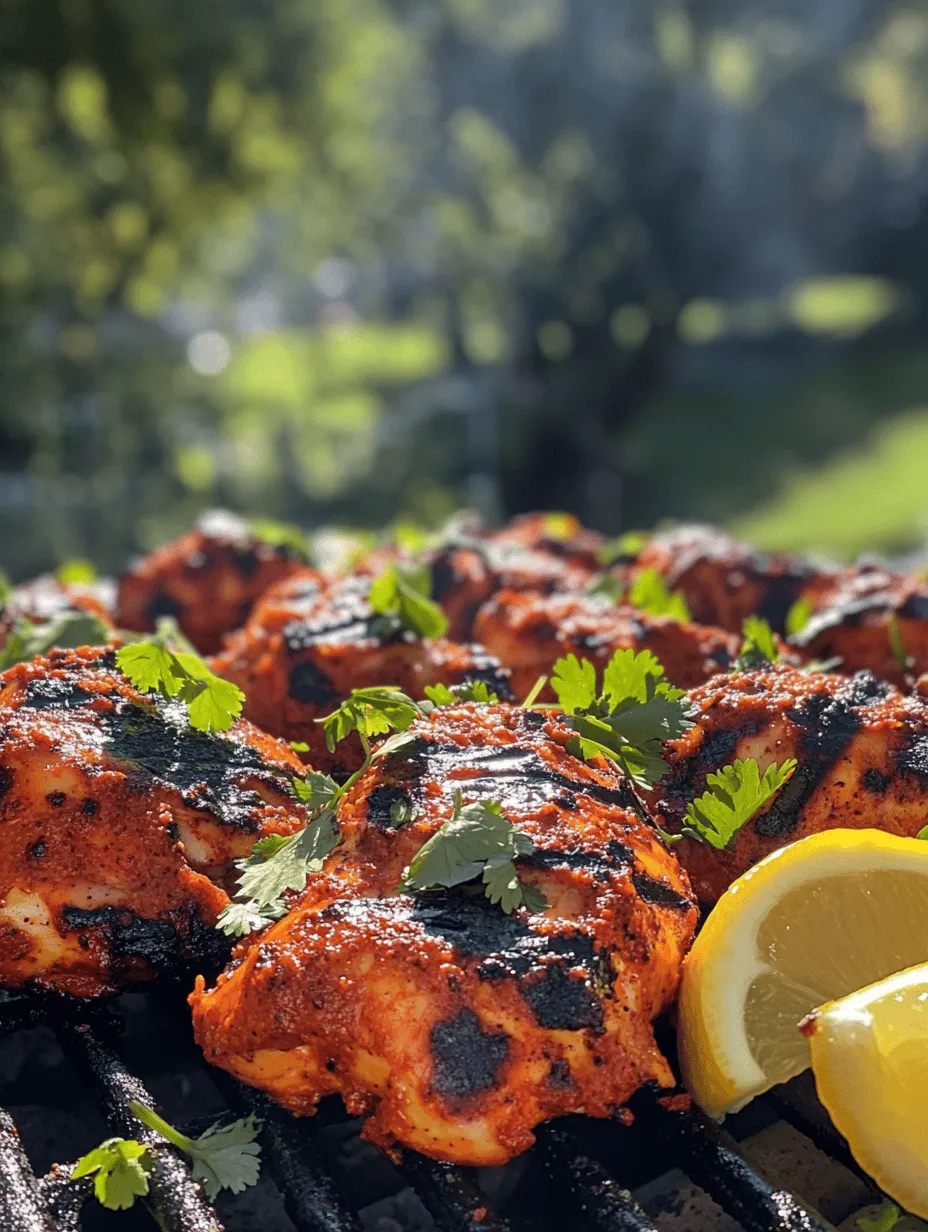Introduction
Tandoori chicken is a beloved dish that showcases the rich culinary heritage of Indian cuisine. Originating from the northern regions of India, this dish is known for its vibrant color, tantalizing aroma, and complex flavors that come from a unique blend of spices. Traditionally, tandoori chicken is cooked in a tandoor, a cylindrical clay oven that reaches high temperatures, imparting a distinct smokiness and char that is hard to replicate. However, grilling tandoori chicken at home can yield equally delicious results, making it accessible for everyone to enjoy this culinary delight.
One of the most critical elements in achieving authentic tandoori chicken flavor is the marination process. The chicken is typically marinated for several hours, or even overnight, in a mixture of yogurt and spices, which not only tenderizes the meat but also infuses it with a depth of flavor that can transport your taste buds straight to India. The grilling method adds another layer of complexity, creating a beautiful caramelization on the outside while keeping the inside juicy and flavorful.
In this article, we will walk you through an easy yet flavorful recipe for grilled tandoori chicken that anyone can try at home. Whether you’re a seasoned cook or a novice in the kitchen, you’ll find that this dish is not only satisfying to make but also a hit at any gathering.
Understanding Tandoori Chicken
Tandoori chicken is more than just a dish; it’s a representation of India’s vibrant food culture. Historically, this dish has roots that date back centuries, where it was traditionally prepared by cooks in North India who utilized the tandoor oven. The tandoor is designed to maintain high heat, allowing for a unique cooking process that enhances the flavors of the meat. The charred exterior and smoky flavor produced in the tandoor are what make this dish so iconic.
While the traditional method involves cooking the chicken on skewers in a tandoor, grilling can effectively replicate the flavors and textures. By using a grill, whether gas or charcoal, you can achieve the same high temperatures that mimic the tandoor, resulting in a perfectly cooked chicken with a delightful smoky flavor.
The key to tandoori chicken lies in its spices. The traditional spice blend includes a combination of cumin, coriander, turmeric, garam masala, paprika, and cayenne. Each of these spices contributes to the overall flavor profile, bringing warmth, earthiness, and a hint of heat that perfectly complements the richness of the chicken. This dish is not just a feast for the palate; it’s also packed with health benefits—many of these spices are known for their anti-inflammatory and antioxidant properties.
Ingredients Breakdown
To create a mouthwatering grilled tandoori chicken, you’ll need a selection of ingredients that work together to enhance the flavor and texture of the dish. Here’s a detailed breakdown of each ingredient and its role:
Chicken Thighs
For this recipe, bone-in, skinless chicken thighs are preferred. The bone helps to keep the meat moist during cooking, while the skin is removed to allow the marinade to penetrate the meat fully. Chicken thighs are generally more forgiving than chicken breasts, which can dry out easily when grilled. Their rich flavor and tender texture make them an ideal choice for tandoori chicken.
Plain Yogurt
Yogurt is essential in the marinade, serving multiple purposes. Its acidity helps to tenderize the chicken, breaking down proteins and resulting in a juicy final product. Additionally, yogurt acts as a carrier for the spices, allowing them to adhere better to the chicken and infuse it with flavor.
Vegetable Oil
Adding a bit of vegetable oil to the marinade not only enhances the flavor but also helps to keep the chicken moist during the grilling process. It aids in achieving that coveted char on the outside while ensuring the meat stays juicy inside.
Lemon Juice
Fresh lemon juice adds brightness to the dish, balancing the richness of the chicken and yogurt. The acidity enhances the flavor profile of the marinade and aids in the tenderization process, making it a crucial ingredient.
Garlic and Ginger
These aromatic elements are foundational in many Indian dishes, and they add depth and complexity to the tandoori chicken. Freshly minced garlic and ginger create a fragrant base that complements the spices and enhances the overall flavor.
Spices
The spices used in tandoori chicken are what truly elevate the dish. Here’s a closer look at the key spices and their contributions:
– Cumin: Adds a warm, earthy flavor and is known for its digestive properties.
– Coriander: Offers a citrusy note that brightens the dish and aids in digestion.
– Turmeric: Known for its vibrant color and anti-inflammatory benefits, turmeric adds a subtle bitterness.
– Garam Masala: A blend of several spices, garam masala brings warmth and complexity to the dish.
– Paprika: Adds mild heat and a beautiful red color, enhancing the visual appeal.
– Cayenne: Introduces a kick of heat; adjust to your preference for spice.
– Salt: Essential for enhancing all the flavors in the dish.
Fresh Cilantro and Lemon Wedges
For garnish, fresh cilantro adds a burst of color and freshness, while lemon wedges serve as a bright accompaniment when serving. They can be squeezed over the grilled chicken to enhance the flavors even further.
Preparing the Marinade
Creating the perfect tandoori marinade is simple and rewarding. Here’s a step-by-step guide to making it:
1. Combine Ingredients: In a large mixing bowl, combine the plain yogurt, vegetable oil, lemon juice, minced garlic, minced ginger, and all the spices. Whisk everything together until you achieve a smooth and consistent mixture.
2. Achieve the Right Consistency: Ensure that the marinade is not too thick; you want it to coat the chicken evenly. If it appears too thick, you can add a little more yogurt or a splash of water to loosen it up.
3. Marinate the Chicken: Add the chicken thighs to the marinade, ensuring each piece is thoroughly coated. For maximum flavor, cover the bowl with plastic wrap and refrigerate the chicken for at least 2 hours, but preferably overnight. This marination time allows the spices to penetrate the meat, resulting in a more flavorful dish.
4. Customize Spice Levels: If you prefer a milder flavor, you can reduce the amount of cayenne pepper in the marinade. Conversely, if you like it spicy, feel free to increase the cayenne and add more chili powder or paprika.
By following these steps, you’ll set the stage for a delicious grilled tandoori chicken that’s bursting with flavor. The marination process is not just about flavor but also about ensuring the chicken is tender and juicy. Whether for a family dinner or a weekend barbecue, this recipe will surely impress and tantalize the taste buds.

Marinating the Chicken
Best Practices for Marinating Chicken Thighs
Marinating is the key to infusing flavor and tenderness into your grilled Tandoori chicken. When it comes to chicken thighs, they are ideal for marinating due to their higher fat content compared to chicken breasts, which helps retain moisture during cooking. Here are some best practices for marinating chicken thighs:
1. Use a Non-Reactive Container: Opt for glass, ceramic, or food-safe plastic containers for marinating. Avoid metal containers, as they can react with the acidic ingredients in your marinade.
2. Ensure Even Coating: Place the chicken thighs in the marinade and ensure each piece is thoroughly coated. You can use a zip-top bag for this, allowing you to massage the marinade into the chicken for better absorption.
3. Incorporate Aromatic Ingredients: Along with yogurt and spices, consider adding garlic, ginger, or fresh herbs to enhance the flavors. The acidity from yogurt not only flavors the chicken but also helps to tenderize it.
Recommended Marination Times and How They Affect Flavor
The flavor profile of your Tandoori chicken is significantly influenced by the marination time. Here are some recommendations:
– Minimum Time: For a quick marinade, allow the chicken to sit for at least 30 minutes. This will impart a basic flavor but won’t achieve the depth that longer marination provides.
– Optimal Time: For the best results, marinate the chicken for 4 to 6 hours. This period allows the spices to penetrate deeply, resulting in a more flavorful and tender chicken.
– Overnight Marination: If time permits, marinating overnight (up to 24 hours) is ideal. The longer the chicken sits in the marinade, the more pronounced the flavors will be, and it will be incredibly tender.
Importance of Refrigeration During Marination
Always marinate chicken in the refrigerator to prevent the growth of harmful bacteria. Keeping the chicken cold during marination ensures that it remains safe to eat while allowing the flavors to develop. If marinating for longer than two hours, it’s crucial to maintain this temperature to preserve the quality and safety of the meat.
Grilling Techniques for Tandoori Chicken
Preparing the Grill: How to Achieve the Ideal Temperature (400°F to 450°F)
Achieving the right grill temperature is crucial for Tandoori chicken, which requires intense heat for proper cooking and charring. Here’s how to prepare your grill:
1. Preheat the Grill: If using a charcoal grill, light the charcoal and let it burn until covered in white ash, which should take about 20-30 minutes. For a gas grill, ignite the burners and set them to medium-high. Aim for a temperature range of 400°F to 450°F.
2. Use a Grill Thermometer: Investing in a grill thermometer can help you monitor the temperature accurately. This ensures that your chicken cooks evenly and develops the desired char without burning.
Grilling Methodology
1. Proper Placement of Chicken on the Grill: Once your grill is at the right temperature, remove the chicken from the marinade and let any excess drip off. Place the chicken thighs skin-side down on the grill grates, ensuring they are not overcrowded. This allows for even cooking and proper airflow.
2. Timing for Achieving the Perfect Char and Doneness: Grill the chicken for about 6-8 minutes on each side. The exact timing may vary based on the thickness of the thighs and the heat of your grill. Aim for a nice char on both sides while keeping an eye on the temperature.
3. Utilizing a Meat Thermometer to Ensure Food Safety: To guarantee that your chicken is fully cooked and safe to eat, use a meat thermometer to check the internal temperature. The chicken should reach an internal temperature of 165°F. Insert the thermometer into the thickest part of the thigh, avoiding contact with the bone for an accurate reading.
Letting the Chicken Rest
Explanation of Why Resting Chicken is Crucial for Juiciness
After grilling, it’s tempting to dive right into your Tandoori chicken, but allowing it to rest is essential. Resting gives the juices time to redistribute throughout the meat, resulting in a juicier and more flavorful dish. Cutting into the chicken too soon can lead to a dry texture as the juices escape.
Recommended Resting Time and What to Expect After Resting
Let the grilled chicken rest for at least 5-10 minutes. During this time, cover the chicken loosely with aluminum foil to keep it warm. Once rested, you’ll find that the juices have settled, enhancing the overall taste and moisture of each bite.
Serving Suggestions
Presentation Ideas for Grilled Tandoori Chicken
When it comes to serving grilled Tandoori chicken, presentation enhances the eating experience. Here are some creative ideas:
– Garnish with Fresh Herbs: Sprinkle chopped cilantro or parsley over the chicken before serving to add a pop of color and freshness.
– Serve on a Platter: Arrange the chicken on a large serving platter with lemon wedges and colorful vegetables like bell peppers or red onions for an eye-catching display.
Suggested Sides to Complement the Dish
Grilled Tandoori chicken pairs beautifully with various sides. Consider serving:
– Naan or Roti: Soft Indian bread is perfect for scooping up the chicken and any accompanying sauces.
– Basmati Rice: Fluffy basmati rice seasoned with spices makes a great base for your Tandoori chicken.
– Salad: A cooling cucumber salad or a simple green salad with a yogurt dressing can balance the spices of the chicken.
How to Use Lemon Wedges Effectively for Added Flavor
Lemon wedges are a classic accompaniment to Tandoori chicken. Squeeze fresh lemon juice over the chicken just before serving to brighten the flavors and add a zesty kick. The acidity cuts through the richness of the marinade, enhancing the overall taste.
Nutritional Information
Overview of the Health Benefits of Tandoori Chicken
Grilled Tandoori chicken is not only delicious but also nutritious. Here are some health benefits:
– High in Protein: Chicken is an excellent source of lean protein, essential for muscle repair and overall health.
– Lower in Fat: Grilling reduces the amount of fat compared to frying, making it a healthier cooking method.
– Rich in Spices: The spices used in Tandoori marinade, such as turmeric and cumin, have anti-inflammatory properties and may provide various health benefits.
Nutritional Breakdown Per Serving
Here’s a general nutritional breakdown for one serving (approximately 4 oz) of grilled Tandoori chicken:
– Calories: 230
– Protein: 25g
– Fat: 12g
– Carbohydrates: 5g
– Fiber: 1g
This breakdown highlights the balance of flavors and nutrition in Indian cuisine, showcasing how traditional dishes can fit into a healthy diet.
Conclusion
In conclusion, grilled Tandoori chicken is a simple yet flavorful dish that brings the vibrant tastes of Indian cuisine to your table. The marination process enhances the chicken’s tenderness and infuses it with aromatic spices, while grilling brings out a delicious char that complements the dish perfectly. With thoughtful serving suggestions and a focus on nutrition, this recipe is not only satisfying but also a healthy option for any meal.
We encourage you to try making this Tandoori chicken at home, as it’s an accessible way to explore Indian flavors and traditions. Cooking is about sharing joy and experiences, so gather your loved ones and enjoy the delightful flavors of homemade Tandoori chicken together.



